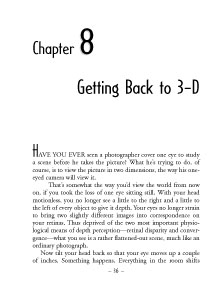 |
| To regain a three-dimensional view of the world, Mr. Brady suggests two approaches: create relative motion, or use the techniques used by artists to lend depth to a two-dimensional scene. "In the absence of binocular vision, relative motion is going to be your prime visual tool in the highly mobile world of driving, flying, boating, skiing, skating and skin diving, and in occupations involving moving objects or vehicles. Knowledge of how to create it when it doesn't occur by itself can hasten your return to your favorite sport or the wheel of your car." (pg. 41) "When viewing a stationary object at short range, one very effective way to produce something akin to relative motion is to move your head quickly to one side. This not only creates a slight shift of the object against its background (as did the up-and-down head movement described earlier in this chapter), it also enables you to have two slightly different views of the same subject in such rapid sequences that the brain can interpret them much the same as it would interpret a double image produced by two eyes." (pg. 43) To regain a more 3-dimensional perspective, Mr. Brady suggests techniques used by Leonardo da Vinci to add depth to his art: • * Objects in the foreground take up more of the window's space than objects of the same size in the distance. Automobiles. which are fairly standardized in size, are a good gauge of this. Leonardo calls this phenomenon"diminishing perspective." • Colors are bolder and brighter in the foreground. In the distance, they become softer an muted. By the same token, shadows of nearby objects are sharper and darker. The artist calls this "color perspective." • Finally, objects in the distance tend to blur, while those in the foreground are more clearly defined--"vanishing perspective." "These observations are as precious to the one-eyed person as they are to the painter, for each of them can be translated into improved depth perception. It's a process you can hasten by consciously applying your attention to it--and as a fringe benefit you'll find the world a far more fascinating place to view." (pg. 44) Chapter 1. An Unhappy Landing Chapter 2. An Awkward Takeoff Chapter 3. Jolts of Reality Chapter 4. Flying High Chapter 5. How About You? Chapter 6. Seeing in 3-D—How It Works Chapter 7. What Has Changed? Chapter 8. Getting Back to 3-D Chapter 9. Avoiding Problems and Possible Mistakes Chapter 10. In the Driver’s Seat Chapter 11. The Active Life Chapter 12. Let Technology Help Chapter 13. Keeping the Good Eye Good Chapter 14. Seeing to Your Looks Chapter 15. Eye-making (Ocularistry) Chapter 16. Driving and Piloting Licenses Chapter 17. For Parents Only Chapter 18. Senior Class Chapter 19. In Good Company Glossary Resources |